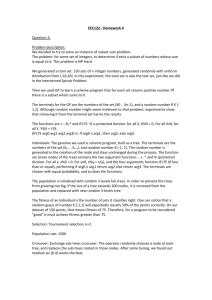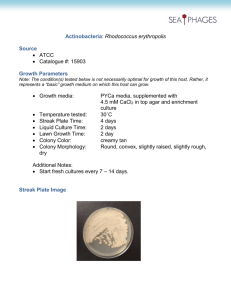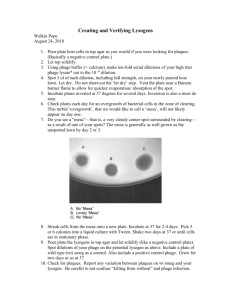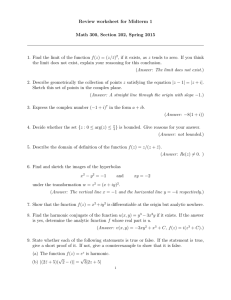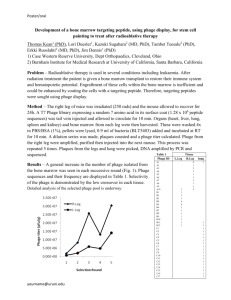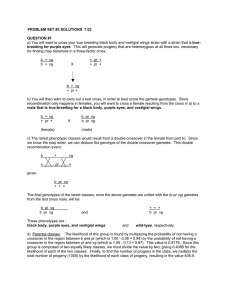7.03 Problem Set 2
advertisement
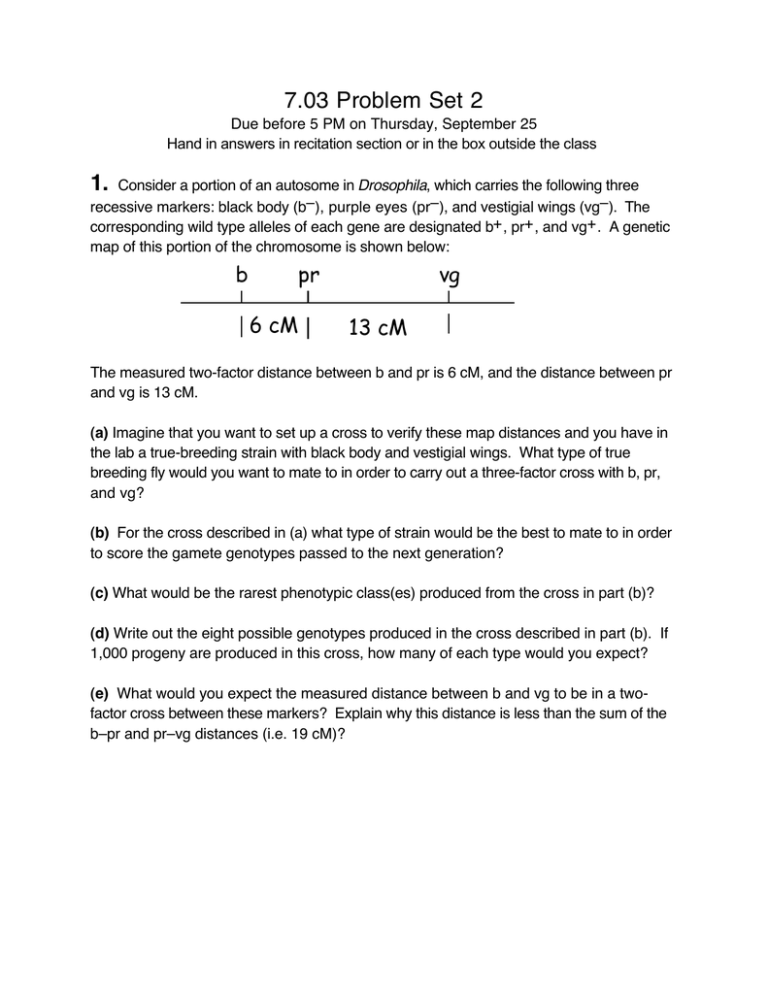
7.03 Problem Set 2 Due before 5 PM on Thursday, September 25 Hand in answers in recitation section or in the box outside the class 1. Consider a portion of an autosome in Drosophila, which carries the following three recessive markers: black body (b–), purple eyes (pr–), and vestigial wings (vg–). The corresponding wild type alleles of each gene are designated b+ , pr+ , and vg+ . A genetic map of this portion of the chromosome is shown below: b pr 6 cM vg 13 cM The measured two-factor distance between b and pr is 6 cM, and the distance between pr and vg is 13 cM. (a) Imagine that you want to set up a cross to verify these map distances and you have in the lab a true-breeding strain with black body and vestigial wings. What type of true breeding fly would you want to mate to in order to carry out a three-factor cross with b, pr, and vg? (b) For the cross described in (a) what type of strain would be the best to mate to in order to score the gamete genotypes passed to the next generation? (c) What would be the rarest phenotypic class(es) produced from the cross in part (b)? (d) Write out the eight possible genotypes produced in the cross described in part (b). If 1,000 progeny are produced in this cross, how many of each type would you expect? (e) What would you expect the measured distance between b and vg to be in a twofactor cross between these markers? Explain why this distance is less than the sum of the b–pr and pr–vg distances (i.e. 19 cM)? 2. You have isolated two different yeast mutants that will not grow on medium that lacks arginine. You call these mutants arg1– and arg2–. a) Mating of either arg1– or arg2– to wild type produces diploids that can grow without arginine. Mating of arg1– to arg2– produces a diploid that also can grow on medium without arginine. What do these results tell you about the arg1– and arg2– mutations? b) Sporulation of the diploids produced by the mating of arg1– to arg2– yields tetrads of the following types: type 1 1 Arg+ , 3 Arg– type 2 4 Arg– Out of 20 tetrads, 2 are type 1, and 18 are type 2. Categorize each of the tetrad types as parental ditype (P), tetratype (T), or nonparental ditype (N). If the markers are linked give the distance between them in cM. Does this result tell you anything new about the gene(s) mutated in arg1– and arg2–? c) Now you isolate a third mutant called arg3–. When this mutant is mated to wild type the resulting diploids cannot grow without arginine. When arg3– is mated to arg1– the resulting diploid cannot grow without arginine. What do these results tell you about arg3– and its relationship to arg1–? d) When the diploid produced by mating arg3– to arg1– is sporulated tetrads of three types are produced. type 1 1 Arg+ , 3 Arg– type 2 4Arg– type 3 2 Arg+ , 2 Arg– Out of 20 tetrads, 12 are type 1, 5 are type 2, and 3 are type 3. Categorize each of the tetrad types as parental ditype (P), tetratype (T), or nonparental ditype (N). What does this result tell you about the relationship between arg3– and arg1–? Give any relevant distances in cM. e) Based on these results deduce the relationship between arg3– and arg2–. In a mating of arg3– to arg2– what would the phenotype of the resulting diploid be? If this diploid were sporulated and 60 tetrads were examined how many tetrads of each type would you expect? . 3. You have isolated two temperature-sensitive mutations in phage l. These phage mutants are called ts-1 and ts-2. Each mutant will form plaques at 30˚C but not at 42˚C. You cross ts-1 to ts-2 phage by coinfecting E. coli at the permissive temperature of 30˚C. When the resulting phage lysate is plated at 30˚C you count 105 plaques per ml of phage lysate, but when the same phage lysate is plated at 42˚C, there are 300 plaques per ml. (a) What is the distance between the ts-1 and ts-2 mutations in m.u.? You next cross a ts-1 phage strain to a ts-2 phage strain that also carries a cI– mutation, which gives plaques with clear centers. When the resulting lysate is plated out at 42˚C and 100 plaques are examined, 85 are clear and 15 have normal turbid centers. (b) If the page produced from this cross were plated at 30˚C, what fraction of the plaques would you expect to have clear centers? (c) Draw a map showing the relative order of cI–, ts-1 and ts-2 as well as all of the distances you can calculate in m.u.
